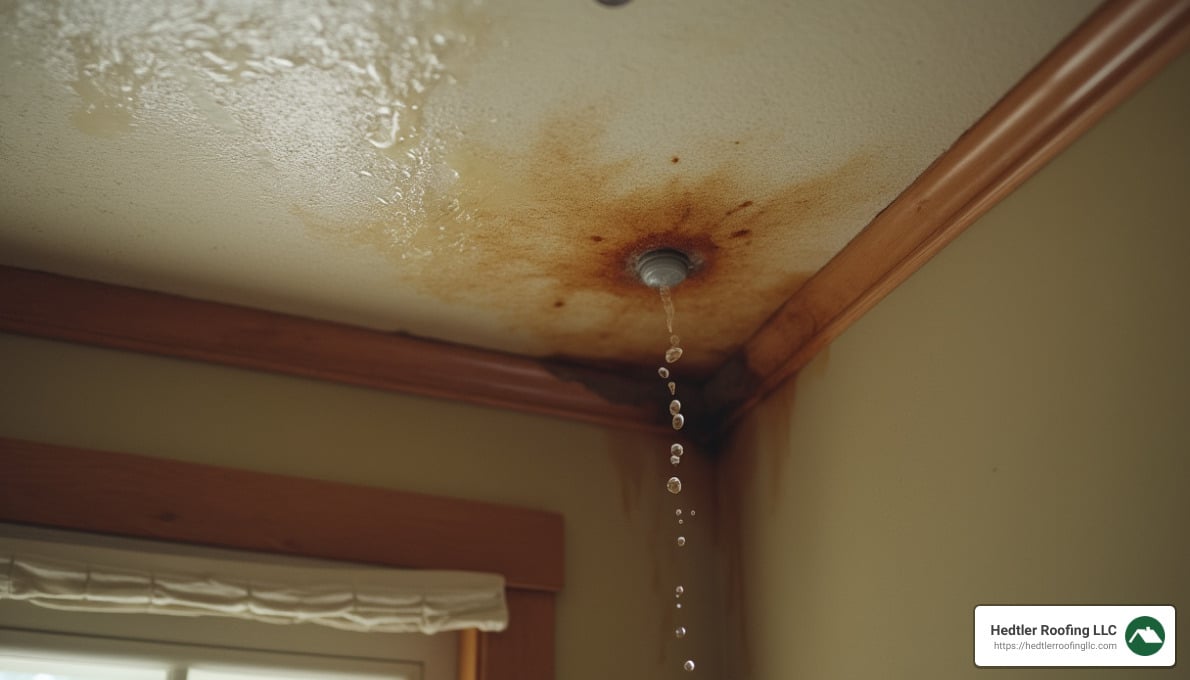How to Fix Leak in Roof from Inside: Top 5 Proven Tips
How to fix leak in roof from inside is a vital skill for many homeowners facing the immediate challenge of a leaking roof, especially during Massachusetts’ unpredictable weather. Addressing these leaks swiftly is crucial. Quick solutions involve:
– Identifying the leak source: Start with visual inspections for stains on ceilings or dripping sounds.
– Making temporary patches: Use roofing tar and a putty knife to seal visible breaches.
– Diverting water: During storms, direct leaks into containers to prevent further damage.
Promptly fixing leaks can mitigate water damage and the formation of mold, saving significant repair costs and maintaining the safety of your living space.
At Roof Experts, we understand the stakes when your roof starts to leak. My name is Jason Hedtler, and I bring over 20 years of experience in roofing solutions, specializing in emergency repairs and preventative measures. Our team is committed to offering high-quality roofing services custom to the needs of homeowners in Franklin and Wareham, MA, ensuring your home remains safe and secure, no matter the weather.

How to fix leak in roof from inside terms to know:
– ceiling leaking water
– handyman roof repair
– roof flashing repair
Identifying the Source of the Leak
When your roof springs a leak, the first step is identifying the source. This might sound simple, but water can be sneaky. It often travels along rafters and beams before dripping down and causing visible damage. Here’s how you can get to the bottom of it:
Visual Inspection
Start with a visual inspection. Look for water stains on your ceilings and walls. These stains often have a dark ring around the edge, indicating where the water is pooling.
Use a flashlight to check for any wet spots or dripping sounds in your attic. Pay close attention to areas around roof decking and insulation. Wet insulation is a clear sign of a leak. You might also notice missing or damaged shingles if water has made its way through your roof.
Conducting a Water Test
If the visual inspection doesn’t reveal the source, it’s time for a water test. This involves using a hose to simulate rainfall. Have someone spray water on different sections of the roof while you stay inside to watch for signs of water entering.
Focus on roof features like skylights, valleys, and chimneys—these are common culprits for leaks. By spraying water and observing, you can often pinpoint the exact location of the leak.

Finding the leak is just the first step. Once you know where it is, you can move on to making emergency repairs or contacting a professional for a more permanent solution. At Roof Experts, we specialize in identifying and fixing leaks efficiently, ensuring your home stays dry and protected.
Emergency Repairs for Leaking Roofs
When you find a leak, acting quickly is key. While finding the source is crucial, sometimes you need to make emergency repairs to prevent further damage. Here’s how you can manage a leaky roof from inside your home.
Diverting the Water
If water is coming through your ceiling, you need to divert it to minimize damage. This can be done with a simple trick using a nail. Insert a nail into the leaking hole to create a path for the water to follow. This will help funnel the water into one direction, making it easier to manage.
Place a 5-gallon bucket under the leak to catch the water. Make sure the bucket is large enough to handle the flow, especially during a heavy downpour. Use plywood to create a stable platform across your ceiling joists if you need to support the bucket.
Making a Temporary Patch
Once you’ve managed the water flow, it’s time to make a temporary patch. This is a short-term fix to hold you over until a professional can address the issue.
- Roofing Cement and Tar: Use a putty knife to apply roofing cement or roof patch tar over the leaking area. This material is great for sealing small cracks and holes.
- Plywood and Plastic Covering: If the leak is extensive, consider using a piece of plywood covered with plastic sheeting. Secure the plastic with shingles or timber to keep it in place. This will create a barrier against incoming water.
- Seal the Edges: Once the patch is in place, use caulking around the edges to ensure a tight seal. This helps prevent water from sneaking under the patch.
These temporary measures are critical in preventing further water damage to your home until you can get professional help. While these fixes can buy you time, they are not permanent solutions. It’s always best to call in experts like Roof Experts for a thorough and lasting repair.
Next, we’ll explore how to fix a leak from inside your attic using more permanent methods.
How to Fix Leak in Roof from Inside
When it comes to fixing a roof leak from inside, the first step is to locate the leak. This might seem straightforward, but water can travel along rafters and drip down far from where it actually enters. Here’s how to manage it efficiently:
Patching the Leak
- Locate the Leak: Start by inspecting your attic. Use a flashlight to check for any damp spots or water stains on the ceiling or insulation. Once you’ve found the source, mark it with chalk for easy identification.
- Remove Insulation: Carefully remove any insulation covering the leak area. This not only helps you see the leak more clearly but also prevents the insulation from getting damaged.
- Apply Roofing Cement: With a putty knife, apply roofing cement directly onto the leak. This will serve as a temporary patch. Make sure to spread it evenly over the area.
- Use Roofing Tar or Bitumen Paint: For added durability, apply a layer of roofing tar or bitumen paint over the cement. Press a shingle into the tar and seal the edges. This helps hold the patch in place.
- Seal the Edges: Once the patch is in place, use additional roofing cement around the edges to ensure a watertight seal.
Replacing Damaged Materials
Sometimes, a temporary patch isn’t enough, and replacing damaged materials is necessary. Here’s how you can do it:
- Identify Damaged Shingles or Flashing: Look for any damaged shingles or flashing around the leak area. These are often the culprits behind persistent leaks.
- Remove the Damaged Piece: Gently lift the surrounding shingles and remove the nails holding the damaged shingle or flashing in place. Carefully slide it out to avoid damaging other parts of the roof.
- Install a New Piece: Replace the damaged material with a new shingle or flashing. Ensure it fits snugly and aligns with the existing roof structure.
- Seal with Roofing Cement: Secure the new piece with roofing cement. Apply it generously to the edges to prevent future leaks.
By following these steps, you can manage a roof leak from the inside effectively. However, these are temporary solutions. For a long-lasting fix, it’s always best to consult with professionals like Roof Experts, who can provide expert repairs and ensure your roof remains leak-free.
Next, we’ll look into how to prevent future leaks through regular inspections and maintenance.
Preventing Future Leaks
Preventing roof leaks is all about staying proactive with regular inspections and maintenance. Let’s explore how you can keep your roof in top shape and avoid costly repairs down the line.
Regular Roof Inspections
Regular inspections are your first line of defense against leaks. Here’s what to focus on:
- Missing or Damaged Shingles: Look for any missing or damaged shingles. These can expose your roof to water damage. A quick visual inspection from the ground can often spot these issues.
- Flashing and Roof Vents: Check the flashing around chimneys, skylights, and vents. Proper sealing is crucial here, as these areas are common culprits for leaks. Ensure that all roof vents are securely sealed and in good condition.
- Interior Signs of Leaks: Don’t forget to inspect your attic. Water stains or damp insulation can be signs of a leak. Use a flashlight to spot any potential trouble areas.

Roof Replacement Considerations
Sometimes, repairs aren’t enough, and a roof replacement becomes necessary. Here are some considerations to keep in mind:
- Roof Age: Asphalt shingles typically last 15-25 years, while metal roofing can last 40-60 years. If your roof is approaching these ages, it might be time to consider a replacement.
- Signs of Wear and Tear: Look for signs like curling, cracked, or missing shingles. These indicate that your roof is reaching the end of its lifespan.
- Roof Replacement Timeline: Plan your replacement during a season with mild weather, as this can make the process smoother and quicker.
By keeping up with regular inspections and knowing when a replacement is necessary, you can prevent future leaks and ensure your roof stays strong and secure.
Next, we’ll address common questions about fixing roof leaks from the inside and explore more solutions.
Frequently Asked Questions about Fixing Roof Leaks from the Inside
How do you fix an internal roof leak?
Fixing an internal roof leak can be a straightforward process if you know what to do. First, locate the leak by looking for water stains or wet spots in your attic. Once found, remove any wet insulation to expose the leak.
Next, clean and dry the area around the leak. Use a scraper to ensure it’s free from debris. Then, apply roofing cement or roof patch tar with a putty knife over the leak. Press a shingle or piece of timber onto the tar to create a temporary patch. Seal the edges with more roofing cement to keep it watertight.
How do you fix a leaking roof without replacing it?
If you’re not ready to replace your roof, you can still fix leaks with some simple steps. Start by identifying the source of the leak. Clean the area thoroughly and ensure it’s dry. Use a roof sealant or roofing cement to cover the leak. This acts as a short-term solution to prevent further water damage.
For a more durable fix, consider using caulking around roof features like vents or chimneys. This helps seal any potential entry points for water. While these repairs are effective, they are not a substitute for a long-term solution like a full roof replacement when necessary.
Will Flex Seal fix a roof leak?
Flex Seal can be a helpful short-term solution for minor roof leaks. It’s a liquid rubber sealant that can be sprayed onto the leak area to stop water from getting in. However, Flex Seal is not designed for heavy-duty, long-term roofing repairs.
For best results, use a roofing-specific sealant or consider calling a professional for a more permanent solution. Always ensure the area is clean and dry before applying any sealant to achieve the best adhesion and effectiveness.
In summary, while there are temporary fixes available for roof leaks, regular maintenance and timely repairs are crucial to keep your roof in excellent condition. Up next, we’ll explore different methods to prevent future leaks and maintain a sturdy roof.
Conclusion
At Roof Experts, we understand that your roof is a crucial part of your home’s structure, protecting you and your family from the elements. We specialize in providing professional roofing services to homeowners in Massachusetts, including roof installations, replacements, and repairs. Our team is committed to delivering high-quality workmanship and excellent customer service, ensuring that your home remains safe and secure.
With over 20 years of experience in the industry, we pride ourselves on our attention to detail and thorough roof inspections. Whether you’re dealing with minor leaks or need a complete roof replacement, our skilled professionals are equipped to handle any roofing challenge. We focus on using the best materials and the latest techniques to ensure long-lasting solutions for your roofing needs.
Regular inspections and maintenance are vital to prevent future leaks and prolong the lifespan of your roof. We recommend checking for missing or damaged shingles, ensuring that roof vents and flashing are properly sealed, and considering roof replacement when signs of wear and tear become evident. For those with older roofs, especially asphalt shingles that typically last 15-25 years, or metal roofing that can last 40-60 years, plan for timely replacements.
If you’re a homeowner in Massachusetts looking for reliable roofing services, trust Roof Experts to provide the expertise and care your roof deserves. We are dedicated to keeping your home safe, dry, and looking its best.
For more information or to schedule a detailed roof inspection, visit our roof repairs page and let us help you maintain the integrity of your home.


